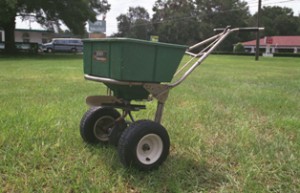
Do you know about the Urban Turf Fertilizer Rule? This rule was put in place in December, 2007 to protect water quality .
Water protection is critical to Florida and on January 8th, 2015 the Florida Department of Agriculture and Consumer Services adopted changes to the statewide Urban Turf Fertilizer Rule.
After 8 years of turfgrass research by the University of Florida (UF), Institute of Food and Agricultural Sciences turf scientists the rule was modified because of their research findings. This research was funded by the Florida Department of Environmental Protection.
Notable changes to this rule include addition of the term “actively growing turf”. Turfgrass that has to be mowed at least once every two weeks to maintain the grass blade at the UF recommended mowing height is considered actively growing. Research demonstrated that timing of fertilizer applications is a key factor for determining nutrient losses to the environment. Fertilizer should ONLY be applied when turf is actively growing.
The rule increased the amount of nitrogen applied in the spring and summer to 2 pounds per 1000 sq. ft, and limits the amount of nitrogen applied during the fall or winter to 1 pound per 1000 sq. ft.
Recommendation to only apply to actively growing turf included:
• No application of nitrogen in the winter months in north Florida.
• Limits nitrogen application rates to 1 pound per application in the fall and winter months in central and south Florida.
• Reduced the maximum annual pounds of nitrogen for Zoysia grass.
The rule included the following statements in the required precautionary language:
• “Apply only to actively growing turf.”
• “Check with your local Cooperative Extension Agency to obtain specific information on local turf best management practices.”
• “Check with your county or city government to determine if there are local regulations for fertilizer use.”
If a total controlled release form of nitrogen is applied, not more than 35 percent of the nitrogen in the controlled release fertilizer can be released within the first 7 days after application.
For more information regarding changes to the Urban Turf Fertilizer Rule please contact the Florida Department of Agriculture and Consumer Services.
Remember, to keep our water clean, be sure to sweep back onto the lawn any grass clippings or fertilizer/chemicals that gets on a hard surface such as a driveway, sidewalk or road, otherwise these items are picked up by rain and carried directly to a water body.
 0
0
